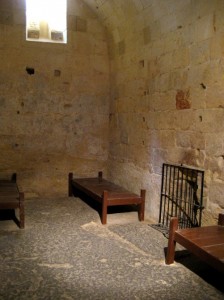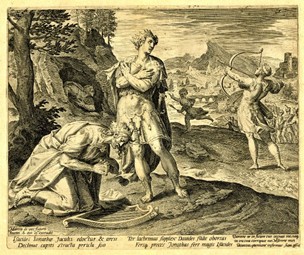 Naomi Pullin is a social and religious historian in the third year of her PhD at the University of Warwick.She researches and writes about the everyday lives and experiences of Quaker women in the seventeenth and eighteenth centuries. In this post she explores the extraordinary friendship between Katharine Evans and Sarah Cheevers (featured in Episode 3 of Five Hundred Years of Friendship) and places it in the religious and social context of its time.
Naomi Pullin is a social and religious historian in the third year of her PhD at the University of Warwick.She researches and writes about the everyday lives and experiences of Quaker women in the seventeenth and eighteenth centuries. In this post she explores the extraordinary friendship between Katharine Evans and Sarah Cheevers (featured in Episode 3 of Five Hundred Years of Friendship) and places it in the religious and social context of its time.
__________
In the autumn of 1658, two Quaker women, Katharine Evans and Sarah Cheevers, set sail for Alexandria on an extraordinary missionary voyage, which they believed was inspired by God. Their plans, however, were foiled after their ship reached Catholic Malta. Here they were detained by the Maltese Inquisition on the charge of blasphemy and were not released until the summer of 1662.

Female cell in the Inquisitor’s Palace in Birgu (Vittoriosa), Malta. This was the prison where Katharine Evans and Sarah Cheevers were held captive. © Mike Fitzpatrick, Annapolis, Maryland
During these three and a half years of brutal persecution, which tested the very foundation of their religious principles, the two women formed an astonishing friendship. It is almost certain that without one another’s spiritual, material and emotional support they would not have survived such a prolonged period of detention in a foreign land. One instance that was particularly telling occurred after one of their captors first attempted to separate them. In an act of defiance, Katharine Evans, took her companion by the arm declared that: ‘The Lord hath joined us together, and woe be to them that should part us […] I rather chuse to dye there with my friend, than to part from her’.[1]
Katharine Evans’s powerful warning to her captors should they part the two friends whom ‘the Lord hath joined together’ was truly symbolic. The two women had never met before their journey to Mediterranean. Katharine Evans was from Bristol and Sarah Cheevers from Slaughterford, in Wiltshire. Yet, after a chance meeting in London in 1657, both women described how they had simultaneously experienced the same God-given calling to travel to Alexandria. The role of the Lord in shaping their alliance was fundamental. It was also an aspect of Quaker understandings of friendship that differed markedly from the rest of seventeenth-century society. This was owing to the fact that writers believed that friendship should be a rational decision entered into by both parties. In a culture founded on credit and personal connections, it was also expected to have a practical or material outcome. Quaker friendship, on the other hand, was almost completely determined by a shared spiritual affinity.
Female ministers modelled their missionary activities on the work of the Apostles and believed that the physical torments and spiritual trials that they underwent identified them as Christ’s true followers. The many trials faced by these sufferers were therefore mitigated through their supportive partnership. The conditions that they were confronted with in the Maltese prison were brutal to say the least. They were confined to a tiny airless cell without access to light, water, or regular supplies of food. It would be something akin to the women’s cell pictured above in the Inquisitor’s Palace in Birgu, where Evans and Cheevers were held captive for some time. The women note in their account how their skin was parched and their hair fell out from the intense heat, which naturally caused them much emotional and physical anxiety. At one point, Katharine Evans poignantly stated that ‘we sought death, but could not find it; We desired to die, but death fled from us’.[2] It was the support and companionship that they had from one another which sustained them. When Katharine Evans fell very ill and nearly died, it was Sarah who struck a deal with their captors to get her friend hot food and to wash her linen. Without any money of her own, or the physical strength to source food, it is likely that Katharine would have died without the support and sustenance that her companion provided for her.
One of the other ‘crosses’ or trials that they had to bear included long-term separation from their families. Both women were the mothers of several young children, who they left in the care of their husbands and relatives in order to undertake their service. From their surviving correspondence, it is clear that their forced separation from their families was a matter of much distress for both women. For Sarah, this was made all the more harder, because her husband had not converted to Quakerism and did not support her decision to travel. However, it is likely that this also heightened their experience of friendship with one another, which served as a means of countering the effects of isolation and separation. Like many Quakers, they referred to one another as a ‘Sister in Christ Jesus’, which suggested a deeper connection than mere friendship.
The spiritual friendship expressed between the two women also had scriptural undertones, which was reminiscent of the friendship of David and Jonathan, whose souls were described as being ‘knit together’ (1 Samuel 18: 1). This was evidenced when the two women were physically separated and interrogated, yet ‘were guided by one Spirit’. Their captors tried to turn the women against one another in an attempt to encourage them to relinquish their beliefs. Yet, something miraculous happened whereby both friends spoke ‘one and the same thing in effect, so that they had not a jot nor tittle against us’.[3] In preaching the same message to their captors, the spiritual foundation of their friendship was at its strongest: they were united as one, like David and Jonathan.
Owing to the intensity of their relationship, the account of Jonathan and David has often been mistaken as a story of two lovers. Similarly, Katharine Evans and Sarah Cheevers’ account of friendship has repeatedly been cast as an eroticised or sexual relationship. It would be wrong to assume that these women would envisage their alliance in these terms. Nevertheless, the language which they used to describe their relationship was highly unusual. Like many other female ministers, they called each other ‘yokemates’ or ‘helpmeets’. It is an interesting choice of expression, as these terms were traditionally used to describe the husband-wife relationship. Indeed, sixteenth and seventeenth-century writers believed that true friendship was only attainable within marriage, because husband and wife shared one body as well as one soul. It was an image that was reminiscent of domestic harmony, but it also suggested a relationship of long-term devotion. Thus when Katharine Evans described her companion as ‘My dear and faithful Yoke-fellow, Sister and Friend’, she was drawing upon a whole repertoire of images that suggested a powerfully enduring emotional, as well as spiritual connection.[4]
The story of Katharine Evans and Sarah Cheevers’ capture and imprisonment in Malta is an important example of Quaker female friendship at its most powerful. Despite the fact that they had never met before undertaking their voyage, these women formed a sympathetic companionship with one another, sharing the physical, social and emotional burdens of travelling ministry. Moreover, the spiritual union that they experienced during their missionary work served to heighten their relationship with both God and with one another. ‘Their mutuality’, as their biographers have written, ‘confirmed and generated the emotional and spiritual strength which, along with their belief, allowed them to endure physical suffering and spiritual attack’.[5] It is worth remembering that women like Katharine Evans and Sarah Cheevers formed part of a global network of ‘Friends’. Whilst, members of the Society were urged to relinquish all worldly attachments, in order to better achieve a personal relationship with God, they shared an important spiritual bond or connection. As the alliance of Evans and Cheevers demonstrates, this intense spirituality could sustain them through extraordinary trials and life-threatening situations
___________
Follow Naomi Pullin on Twitter: @naomipullin
[1] Katharine Evans and Sarah Chevers, This is a short relation of some of the cruel sufferings (for the truths sake) of Katharine Evans and Sarah Chevers In the Inquisition In the Isle of Malta (London, 1662), pp. 13-4.
[2] Evans and Sarah Chevers, This is a short relation of some of the cruel sufferings (for the truths sake) of Katharine Evans and Sarah Chevers, p. 13.
[3] Evans and Sarah Chevers, This is a short relation of some of the cruel sufferings (for the truths sake) of Katharine Evans and Sarah Chevers, p. 17.
[4] Evans and Sarah Chevers, This is a short relation of some of the cruel sufferings (for the truths sake) of Katharine Evans and Sarah Chevers, p. 63.
[5] E. Graham, H. Hinds, E. Hobby, H. Wilcox (eds.), Her own Life: Autobiographical Writings by 17th Century Englishwomen (London, 1989), p. 117.

